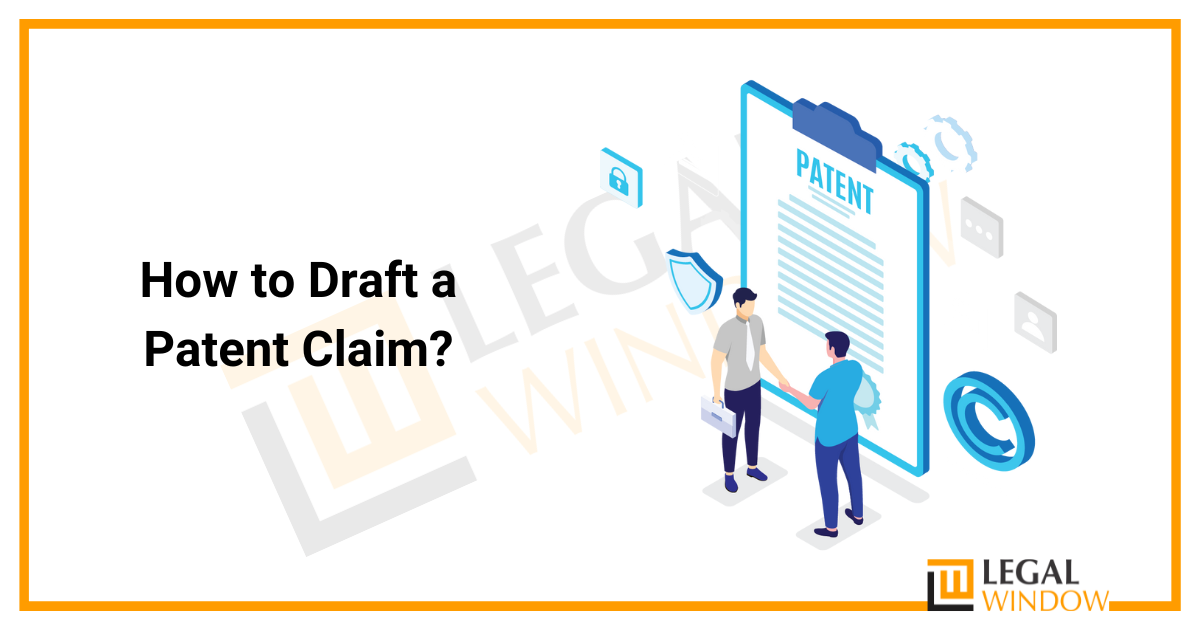
A patent is a privilege granted to an individual, whether natural or artificial, by the government through the Patent Act, of 1970 that prohibits others from using/selling/importing the patented product or procedure without the inventor’s prior consent. When a patent is registered under the Patent Act, of 1970, it becomes permanent and grants the inventor the sole legal right to prevent others from utilizing a particular innovation. The right to protection is granted for 20 years, after which time the innovation enters the public domain and can be exploited by anyone. According to the legal rights granted to the patent holder, he/she/it may initiate an action against the person who infringes the patent or misrepresents or misuses the same. This article talks about how to draft a patent claim.
| Table of Content |
Short Glimpse
A patent is an intellectual property granted to innovations, and it is an exclusive right granted by the government to the patentee in return for the disclosure of their invention for a certain period of time. In India, a novel product or technique of innovation that has an innovative step and is also capable of industrial application can be patented.
Before we move on to discuss How to Draft a Patent Claim? Let us first discuss what are Patent Claim actually is.
Meaning of Patent Claim
Patent claims are the sections of the patent specification that establish the scope of patent protection. They are the foundation of the legal and moral protection afforded by patents. One of the primary roles of the patent claim is to define the patent’s scope. In certain ways, claims act as a boundary line; if someone crosses it, it amounts to infringement of the patent holder’s rights. Because the claims are so important, they must be carefully written to provide total protection. If it is not correctly phrased, it may generate issues with prosecution and lawsuits.
As a result, it is recommended that inventors seek the assistance of legal specialists while preparing claims, as it is regarded as a legal document. The patent includes an exclusive right to prevent anyone from selling, producing, or offering for sale the subject matter indicated by the claims.
What are the different kinds of Patent Claims?
Patent claims are categorized according to their drafting, innovation, and structure:
- On the basis of Drafting
The following are the Patent Claims based on Drafting:- Original Claims
Original claims are referred to as primary claims. They must identify the key characteristics of an innovative innovation. In relation to prior work, the inventive process must be correctly characterized. - Dependent Claims
Independent claims back up these assertions. They are predicated on independent assertions contained in the specification.
- Original Claims
- On the basis of Invention
The following are the Patent Claims based on Invention:- Product Claims
These are the claims for the product’s protection. Some medical items, for example, are protected because the inventor must disclose the chemical makeup of the product he wishes to protect. - Process Claims
Such assertions are based on a novel and inventive methodology. Only the method of that innovation may be protected, not the finished product.
- Product Claims
- On the basis of the Structure
The following are the Patent Claims based on Structure:- Composition of Matter claims
These claims are often and extensively utilized by patent applicants. If the inventor discovers that his innovation differs from the previous art, he may seek protection. - Means plus Function claim
Because they are not recognized as traditional patent claims, these claims are for computer-related innovations. The scope of the invention is stated in these claims. The description in the claim must back up the phrase.
- Composition of Matter claims
Benefits and Drawbacks of the Patent Claim
The following are the benefits and drawbacks of Patent Claims:
- Benefits
The following are the benefits of Patent Claims:- They safeguard intellectual property: well-written patent claims result in good patents. It aids in the preservation of your exclusive rights to your innovations and creations. If someone buys your innovation or design, you can use it to safeguard it.
- You may provide more information: If you file a patent application, it should be full. If you think of a significant assertion after finishing, you can add it afterward. You can also add or change claims after they have been prosecuted. Make high-quality claims from the start, since without them, your invention or design will not be patentable.
- Drawbacks
The following are the drawbacks of the Patent Claims:- They can be overly Broad: Many of the assertions begin with broad remarks. The assertion should be more precise. Your claim will be rejected if it contains an overly broad statement.
- They can be too Limited: Claims can become too narrow at times; claims should be detailed enough to explain your unique innovation. If your claim is too specific, they may disqualify prospective copies. Specific claims alone will not provide the necessary protection; there must be some detail to back up the claims.
How to Draft a Patent Claim?
Looking at the patent claim structure and categories of claims provided by the World Intellectual Property Organization (WIPO), which you can view here, the following formula is proposed:
Patent Claim- A+B+C
A B C
{put title} comprising: {state the parts one by one} {explain how they are connected with each other}
Each claim is split into three parts:
- Preamble
- Linking word
- The Main Body
Preamble
The preamble determines the category into which an innovation falls. (composition, procedure, or equipment) It also expresses the goal of the invention. It also connects the claims to the title of the invention.
Linking Words
Open-Ended Phrases – “including,” and “defined by” serve to broaden the scope of the assertions.
Closed Phrases – “comprising” and “consists of” aid in the cataloging of the elements discussed.
(For example, a chemical compound has 50% C, 25% D, and 25% E components.)
The Main Body
The Main Body is a logical or inconsistent statement that describes the claim’s content. Not simply the component list.
Criteria for Drafting a Patent Claims
There are three criteria that must be followed while drafting your claims: they must be clear, complete, and supported. Every assertion should be in one phrase, regardless of how lengthy or short it is. The following are the criteria for drafting a Patent Claim:
- Should Be Extremely Clear
Your claim should be clear so that the reader has no difficulty reading it. If you use terms like “thin,” “strong,” “a key component,” or “such as,” it is assumed that you are not clear. These phrases cause the reader to form a subjective judgment rather than an objective observation. - Should be Complete
Every claim must be completed in order to encompass the inventive feature as well as enough components to place the invention in the right context. - Should Be Promoted
The statements must be substantiated by providing descriptions. It implies that all of the features of your innovations that comprise your claim must be described in detail. If you utilize any words in your claims, they must be discovered in the description or deduced from it.
The Common Errors you could make while Drafting Claims
The following are the common error you may make while Drafting Claims:
- Creating your own claims: The element of a patent application that is most challenging to draught is the patent claim. You could get a subpar patent if your claim is incorrect. The claim’s phrasing has to be precise. Hiring a patent attorney to assist with the application procedure is preferable. If you follow through, you’ll get a strong patent.
- Starting with the incorrect assertion: You should start with the broadest assertion possible before moving on to more specific assertions. Sort them from the broadest assertions to the narrowest.
- False claim grouping: Product and process claims are made separately. Grouping dependent claims together are required.
- Incorrect use of antecedents: To make it apparent that you are endorsing the antecedents, use the word “said.” If you are referring to broader concepts, words like “a” or “the” should be used. In your claim, the phrase may be mentioned more than once.
- Inclusion of an insufficient number of claims: A patent examiner may reject one or more of your claims if you include the incorrect number of claims or if he determines that part of your claims is not helpful. In order to safeguard your innovation, you should mention as many as you can.
The Fundamentals of Patent Claim Drafting
The following are the basics of Patent Claims of Patent Drafting:
- The claim must be comprehensive in scope, with nothing superfluous added. The terms “scope,” “characteristics,” and “structure” must be evident while reading the claims.
- The claim must be precise and complete.
- Dependent claims can be used to define the boundaries of the invention with precision and specificity.
- The major attention must be on the “scope,” which allows someone to determine if it includes all aspects of the innovation or not.
- The claims must include both “general” and “particular” assertions. This aids in balancing the invention so that the claims do not leave anything out that the invention does.
- Explaining the link between various components of the invention is critical for efficient claim drafting.
Endnote
Patent claims are critical in the patent process, therefore contact an Intellectual Property attorney to ensure that the claims sufficiently protect the innovation. An experienced patent attorney will be more knowledgeable in drafting patent claims that maximize the patent’s reach.
Legal Window has a team of professionals that will provide you with the greatest legal advice and help, as well as quick delivery and the highest level of customer satisfaction when it comes to getting the Patent. For Patent Registration, please contact our staff at 072407-51000 or by email at admin@legalwindow.in.
CS Urvashi Jain is an associate member of the Institute of Company Secretaries of India. Her expertise, inter-alia, is in regulatory approvals, licenses, registrations for any organization set up in India. She posse’s good exposure to compliance management system, legal due diligence, drafting and vetting of various legal agreements. She has good command in drafting manuals, blogs, guides, interpretations and providing opinions on the different core areas of companies act, intellectual properties and taxation.
Categories
- Agreement Drafting (23)
- Annual Compliance (11)
- Change in Business (36)
- Company Law (148)
- Compliance (90)
- Digital Banking (3)
- Drug License (3)
- FEMA (17)
- Finance Company (42)
- Foreign Taxation (6)
- FSSAI License/Registration (14)
- GST (119)
- Hallmark Registration (1)
- Income Tax (200)
- Latest News (34)
- Miscellaneous (164)
- NBFC Registration (8)
- NGO (14)
- SEBI Registration (6)
- Section 8 Company (7)
- Start and manage a business (21)
- Startup/ Registration (130)
- Trademark Registration/IPR (40)
Recent Posts
- Hostel Facilities for Students/Working Women Eligible for GST Exemption: Madras HC May 3, 2024
- NGO Darpan Registration in Jaipur May 2, 2024
- Registration of Charges with ROC May 1, 2024
About us
LegalWindow.in is a professional technology driven platform of multidisciplined experts like CA/CS/Lawyers spanning with an aim to provide concrete solution to individuals, start-ups and other business organisation by maximising their growth at an affordable cost.









